MAKE A MEME
View Large Image

| View Original: | Sir_George_Vane.jpg (692x900) | |||
| Download: | Original | Medium | Small | Thumb |
| Courtesy of: | www.flickr.com | More Like This | ||
| Keywords: people indoor Philip Mould: Sir George Vane was born into one of the most politically involved families in England during a period of great political upheaval in English history. In his transition from loyal Royalist to active Parliamentarian, he is a classic example of how the English gentry gradually turned against King Charles I. Vane was knighted by the King in 1640 for his part in the Battle of Newburn, asmall skirmish fought against the Scots. Sir George twice led the cavalry charge, and, despite having his horse wounded beneath him, managed to kill one of the Scottish leaders, the Sheriff of Teviotdale. In 1645, shortly before the outbreak of the Civil war, Sir George was appointed High Sheriff of County Durham. And yet, in the same year, Vane was to be found valiantly leading the defenses of Raby Castle, his family seat, against repeated Royalist sieges. In his change of sides, Vane was doubtless swayed by the ardent Parliamentary sympathies of his elder brother, Sir Harry, and perhaps even his Puritanical sister Catherine. but this volte face merely reflected the changing political sympathies of the increasingly powerful English gentry, who, by the late 1640s, has become exasperated by Charles I’s autocratic rule. Ironically, it seems that Sir George switched sides again, for in 1651 he was arrested by the Cromwellian regime for suspected Royalist sympathies. But here, too, he was symbolic of the growing, gradual desire for the eventual Restoration of King Charles II in 1660. Philip Mould: Sir George Vane was born into one of the most politically involved families in England during a period of great political upheaval in English history. In his transition from loyal Royalist to active Parliamentarian, he is a classic example of how the English gentry gradually turned against King Charles I. Vane was knighted by the King in 1640 for his part in the Battle of Newburn, asmall skirmish fought against the Scots. Sir George twice led the cavalry charge, and, despite having his horse wounded beneath him, managed to kill one of the Scottish leaders, the Sheriff of Teviotdale. In 1645, shortly before the outbreak of the Civil war, Sir George was appointed High Sheriff of County Durham. And yet, in the same year, Vane was to be found valiantly leading the defenses of Raby Castle, his family seat, against repeated Royalist sieges. In his change of sides, Vane was doubtless swayed by the ardent Parliamentary sympathies of his elder brother, Sir Harry, and perhaps even his Puritanical sister Catherine. but this volte face merely reflected the changing political sympathies of the increasingly powerful English gentry, who, by the late 1640s, has become exasperated by Charles I’s autocratic rule. Ironically, it seems that Sir George switched sides again, for in 1651 he was arrested by the Cromwellian regime for suspected Royalist sympathies. But here, too, he was symbolic of the growing, gradual desire for the eventual Restoration of King Charles II in 1660. | ||||